Risk-Driven Architecting for Large-Scale Agile Development
VerifiedAdded on 2023/04/05
|7
|928
|437
Report
AI Summary
This report summarizes a paper that explores the challenges and solutions of architecting for large-scale agile software development, focusing on a risk-driven approach. The paper, authored by Ipek Ozkaya, Michael Gagliardi, and Robert L. Nord, examines methods to provide rapid feedback on agile team support. It delves into architecture-centric risk factors, incremental architecture evaluations, and the process of evaluating architecture. The research highlights the importance of addressing risks associated with agile architectural processes, including business and organizational climate, requirement changes, and productivity measures. The study emphasizes the use of architecture trade-off analysis and incremental evaluation sessions to uncover and mitigate architectural risks, ultimately improving the visibility of project status and enhancing risk management tactics.
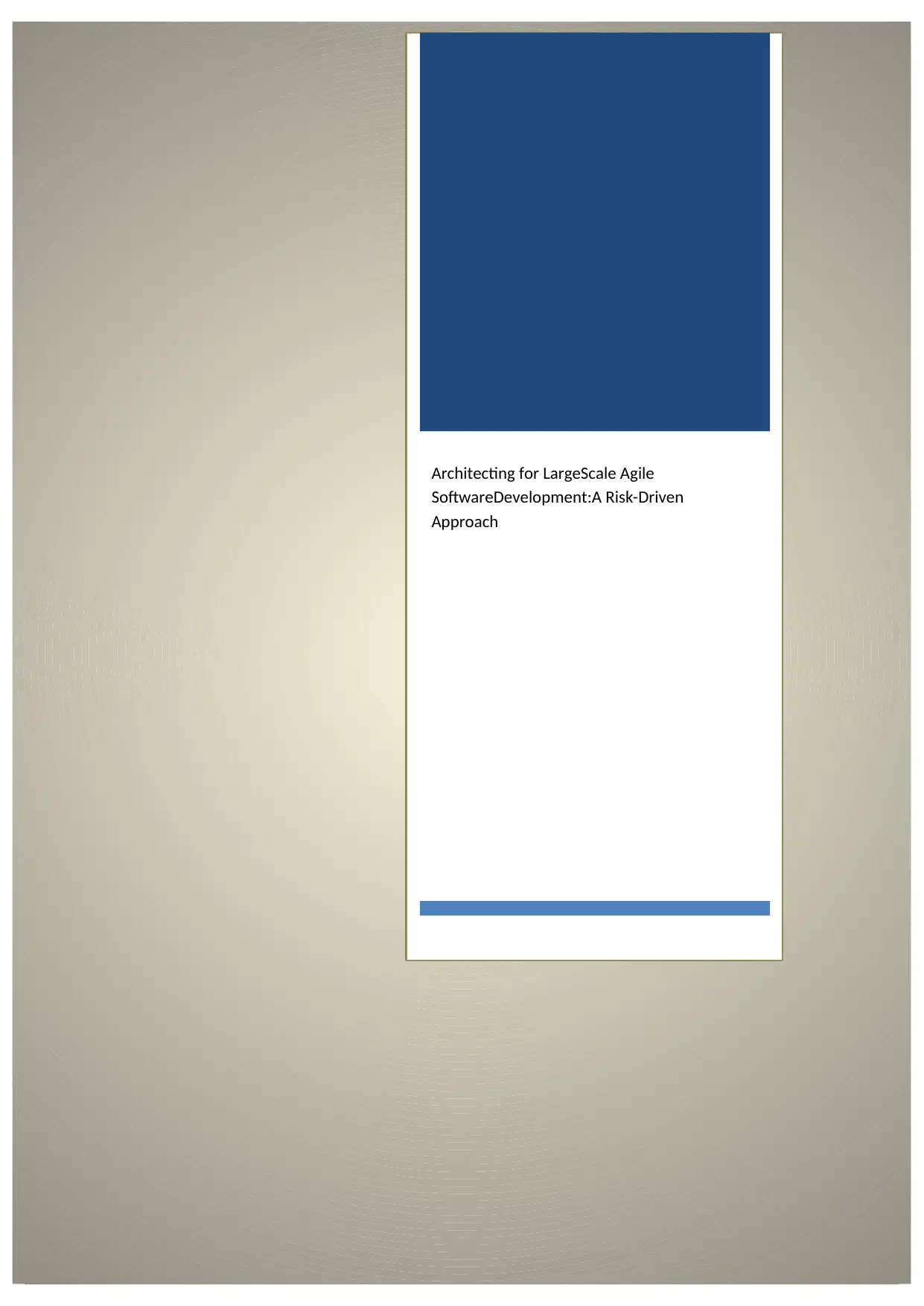
Architecting for LargeScale Agile
SoftwareDevelopment:A Risk-Driven
Approach
SoftwareDevelopment:A Risk-Driven
Approach
Paraphrase This Document
Need a fresh take? Get an instant paraphrase of this document with our AI Paraphraser
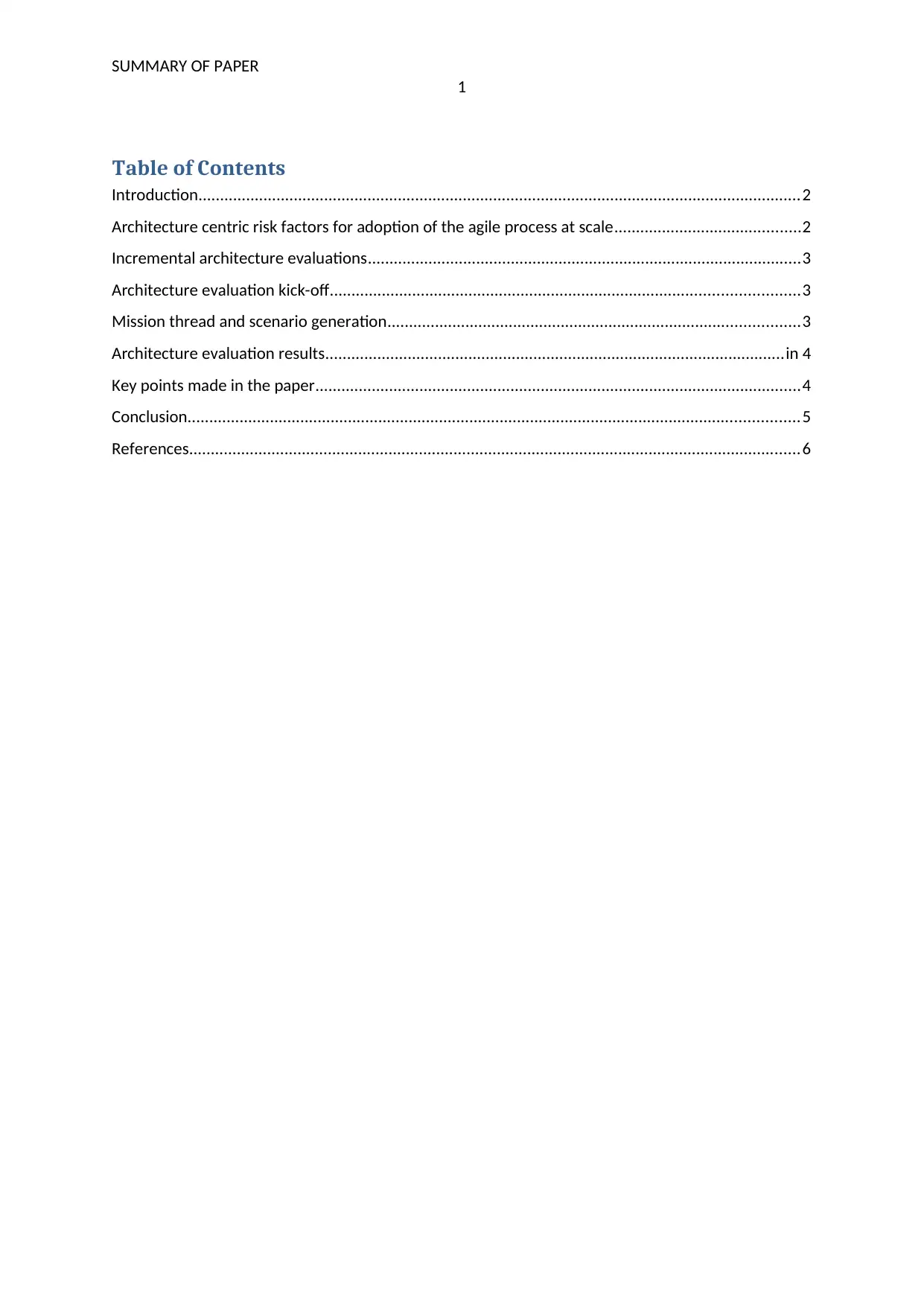
SUMMARY OF PAPER
1
Table of Contents
Introduction...........................................................................................................................................2
Architecture centric risk factors for adoption of the agile process at scale...........................................2
Incremental architecture evaluations....................................................................................................3
Architecture evaluation kick-off............................................................................................................3
Mission thread and scenario generation...............................................................................................3
Architecture evaluation results..........................................................................................................in 4
Key points made in the paper................................................................................................................4
Conclusion.............................................................................................................................................5
References.............................................................................................................................................6
1
Table of Contents
Introduction...........................................................................................................................................2
Architecture centric risk factors for adoption of the agile process at scale...........................................2
Incremental architecture evaluations....................................................................................................3
Architecture evaluation kick-off............................................................................................................3
Mission thread and scenario generation...............................................................................................3
Architecture evaluation results..........................................................................................................in 4
Key points made in the paper................................................................................................................4
Conclusion.............................................................................................................................................5
References.............................................................................................................................................6
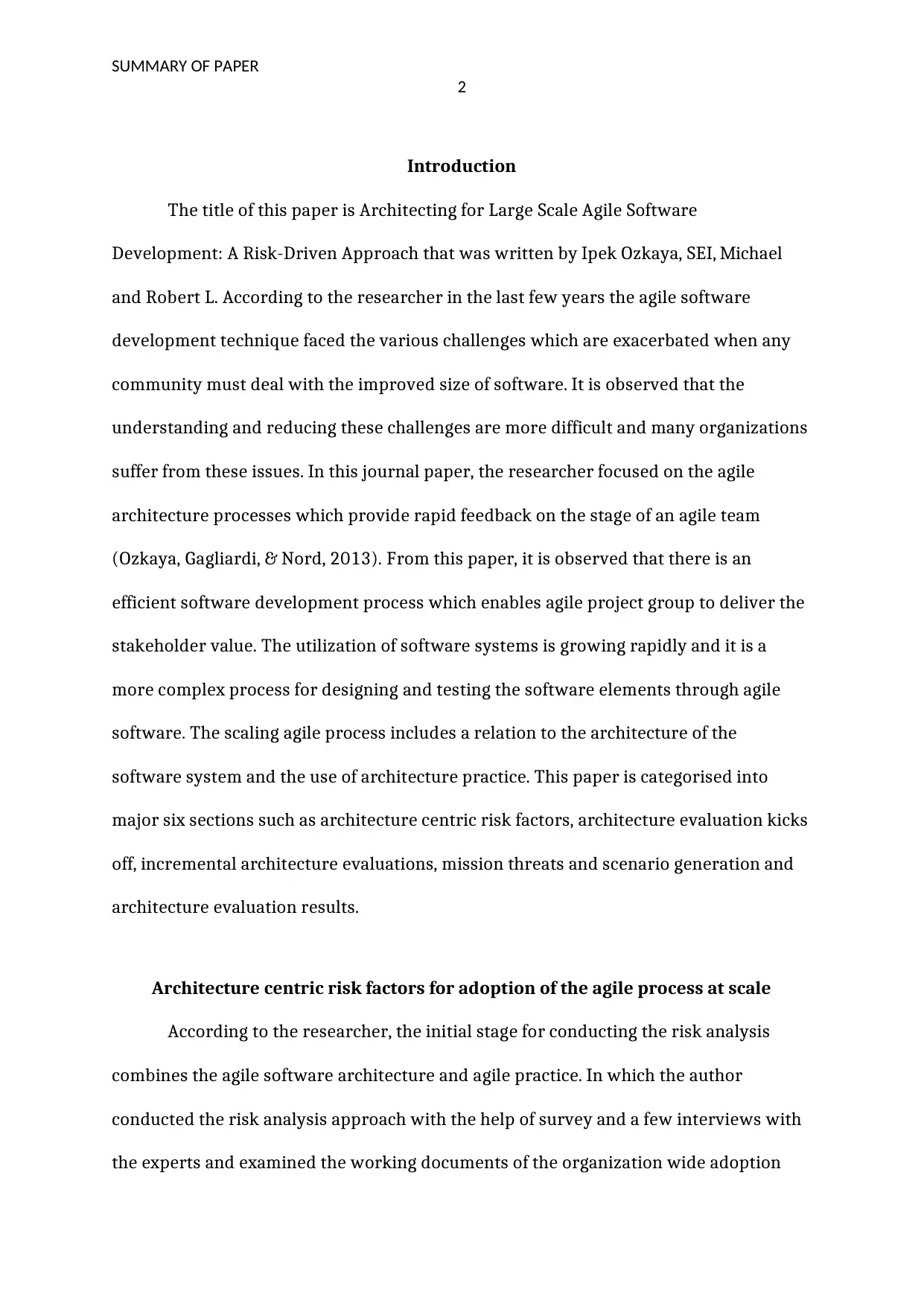
SUMMARY OF PAPER
2
Introduction
The title of this paper is Architecting for Large Scale Agile Software
Development: A Risk-Driven Approach that was written by Ipek Ozkaya, SEI, Michael
and Robert L. According to the researcher in the last few years the agile software
development technique faced the various challenges which are exacerbated when any
community must deal with the improved size of software. It is observed that the
understanding and reducing these challenges are more difficult and many organizations
suffer from these issues. In this journal paper, the researcher focused on the agile
architecture processes which provide rapid feedback on the stage of an agile team
(Ozkaya, Gagliardi, & Nord, 2013). From this paper, it is observed that there is an
efficient software development process which enables agile project group to deliver the
stakeholder value. The utilization of software systems is growing rapidly and it is a
more complex process for designing and testing the software elements through agile
software. The scaling agile process includes a relation to the architecture of the
software system and the use of architecture practice. This paper is categorised into
major six sections such as architecture centric risk factors, architecture evaluation kicks
off, incremental architecture evaluations, mission threats and scenario generation and
architecture evaluation results.
Architecture centric risk factors for adoption of the agile process at scale
According to the researcher, the initial stage for conducting the risk analysis
combines the agile software architecture and agile practice. In which the author
conducted the risk analysis approach with the help of survey and a few interviews with
the experts and examined the working documents of the organization wide adoption
2
Introduction
The title of this paper is Architecting for Large Scale Agile Software
Development: A Risk-Driven Approach that was written by Ipek Ozkaya, SEI, Michael
and Robert L. According to the researcher in the last few years the agile software
development technique faced the various challenges which are exacerbated when any
community must deal with the improved size of software. It is observed that the
understanding and reducing these challenges are more difficult and many organizations
suffer from these issues. In this journal paper, the researcher focused on the agile
architecture processes which provide rapid feedback on the stage of an agile team
(Ozkaya, Gagliardi, & Nord, 2013). From this paper, it is observed that there is an
efficient software development process which enables agile project group to deliver the
stakeholder value. The utilization of software systems is growing rapidly and it is a
more complex process for designing and testing the software elements through agile
software. The scaling agile process includes a relation to the architecture of the
software system and the use of architecture practice. This paper is categorised into
major six sections such as architecture centric risk factors, architecture evaluation kicks
off, incremental architecture evaluations, mission threats and scenario generation and
architecture evaluation results.
Architecture centric risk factors for adoption of the agile process at scale
According to the researcher, the initial stage for conducting the risk analysis
combines the agile software architecture and agile practice. In which the author
conducted the risk analysis approach with the help of survey and a few interviews with
the experts and examined the working documents of the organization wide adoption
⊘ This is a preview!⊘
Do you want full access?
Subscribe today to unlock all pages.

Trusted by 1+ million students worldwide
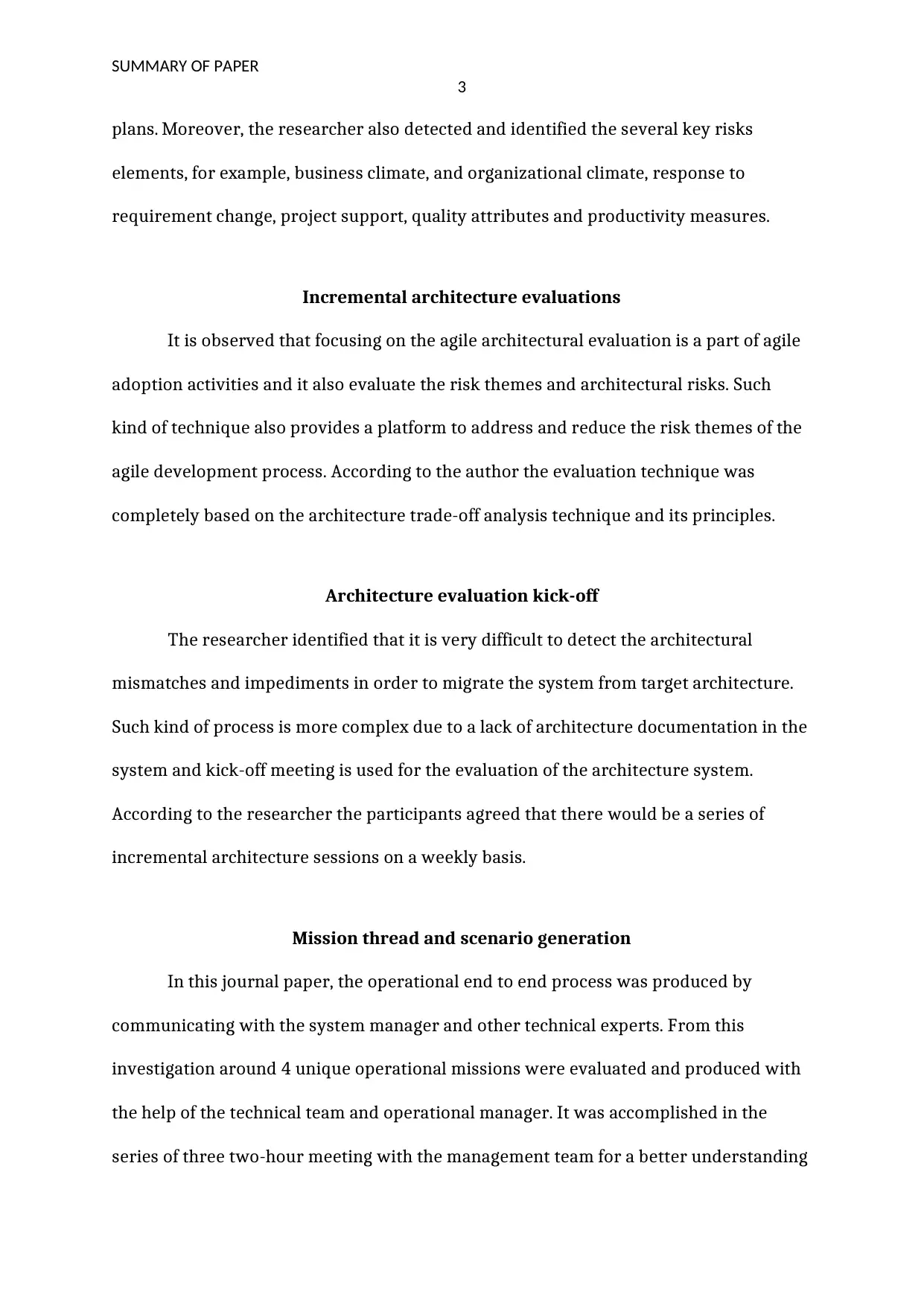
SUMMARY OF PAPER
3
plans. Moreover, the researcher also detected and identified the several key risks
elements, for example, business climate, and organizational climate, response to
requirement change, project support, quality attributes and productivity measures.
Incremental architecture evaluations
It is observed that focusing on the agile architectural evaluation is a part of agile
adoption activities and it also evaluate the risk themes and architectural risks. Such
kind of technique also provides a platform to address and reduce the risk themes of the
agile development process. According to the author the evaluation technique was
completely based on the architecture trade-off analysis technique and its principles.
Architecture evaluation kick-off
The researcher identified that it is very difficult to detect the architectural
mismatches and impediments in order to migrate the system from target architecture.
Such kind of process is more complex due to a lack of architecture documentation in the
system and kick-off meeting is used for the evaluation of the architecture system.
According to the researcher the participants agreed that there would be a series of
incremental architecture sessions on a weekly basis.
Mission thread and scenario generation
In this journal paper, the operational end to end process was produced by
communicating with the system manager and other technical experts. From this
investigation around 4 unique operational missions were evaluated and produced with
the help of the technical team and operational manager. It was accomplished in the
series of three two-hour meeting with the management team for a better understanding
3
plans. Moreover, the researcher also detected and identified the several key risks
elements, for example, business climate, and organizational climate, response to
requirement change, project support, quality attributes and productivity measures.
Incremental architecture evaluations
It is observed that focusing on the agile architectural evaluation is a part of agile
adoption activities and it also evaluate the risk themes and architectural risks. Such
kind of technique also provides a platform to address and reduce the risk themes of the
agile development process. According to the author the evaluation technique was
completely based on the architecture trade-off analysis technique and its principles.
Architecture evaluation kick-off
The researcher identified that it is very difficult to detect the architectural
mismatches and impediments in order to migrate the system from target architecture.
Such kind of process is more complex due to a lack of architecture documentation in the
system and kick-off meeting is used for the evaluation of the architecture system.
According to the researcher the participants agreed that there would be a series of
incremental architecture sessions on a weekly basis.
Mission thread and scenario generation
In this journal paper, the operational end to end process was produced by
communicating with the system manager and other technical experts. From this
investigation around 4 unique operational missions were evaluated and produced with
the help of the technical team and operational manager. It was accomplished in the
series of three two-hour meeting with the management team for a better understanding
Paraphrase This Document
Need a fresh take? Get an instant paraphrase of this document with our AI Paraphraser
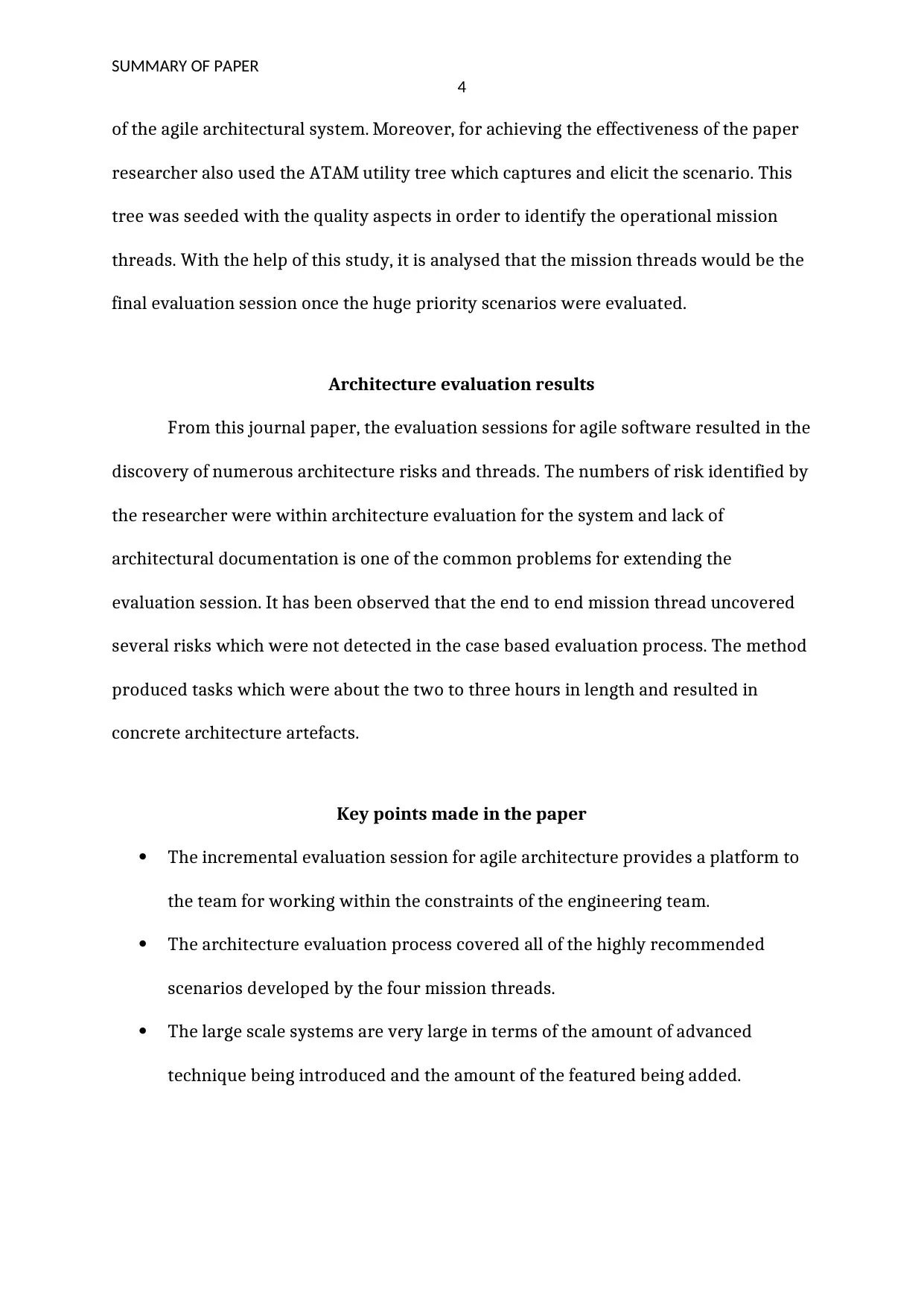
SUMMARY OF PAPER
4
of the agile architectural system. Moreover, for achieving the effectiveness of the paper
researcher also used the ATAM utility tree which captures and elicit the scenario. This
tree was seeded with the quality aspects in order to identify the operational mission
threads. With the help of this study, it is analysed that the mission threads would be the
final evaluation session once the huge priority scenarios were evaluated.
Architecture evaluation results
From this journal paper, the evaluation sessions for agile software resulted in the
discovery of numerous architecture risks and threads. The numbers of risk identified by
the researcher were within architecture evaluation for the system and lack of
architectural documentation is one of the common problems for extending the
evaluation session. It has been observed that the end to end mission thread uncovered
several risks which were not detected in the case based evaluation process. The method
produced tasks which were about the two to three hours in length and resulted in
concrete architecture artefacts.
Key points made in the paper
The incremental evaluation session for agile architecture provides a platform to
the team for working within the constraints of the engineering team.
The architecture evaluation process covered all of the highly recommended
scenarios developed by the four mission threads.
The large scale systems are very large in terms of the amount of advanced
technique being introduced and the amount of the featured being added.
4
of the agile architectural system. Moreover, for achieving the effectiveness of the paper
researcher also used the ATAM utility tree which captures and elicit the scenario. This
tree was seeded with the quality aspects in order to identify the operational mission
threads. With the help of this study, it is analysed that the mission threads would be the
final evaluation session once the huge priority scenarios were evaluated.
Architecture evaluation results
From this journal paper, the evaluation sessions for agile software resulted in the
discovery of numerous architecture risks and threads. The numbers of risk identified by
the researcher were within architecture evaluation for the system and lack of
architectural documentation is one of the common problems for extending the
evaluation session. It has been observed that the end to end mission thread uncovered
several risks which were not detected in the case based evaluation process. The method
produced tasks which were about the two to three hours in length and resulted in
concrete architecture artefacts.
Key points made in the paper
The incremental evaluation session for agile architecture provides a platform to
the team for working within the constraints of the engineering team.
The architecture evaluation process covered all of the highly recommended
scenarios developed by the four mission threads.
The large scale systems are very large in terms of the amount of advanced
technique being introduced and the amount of the featured being added.
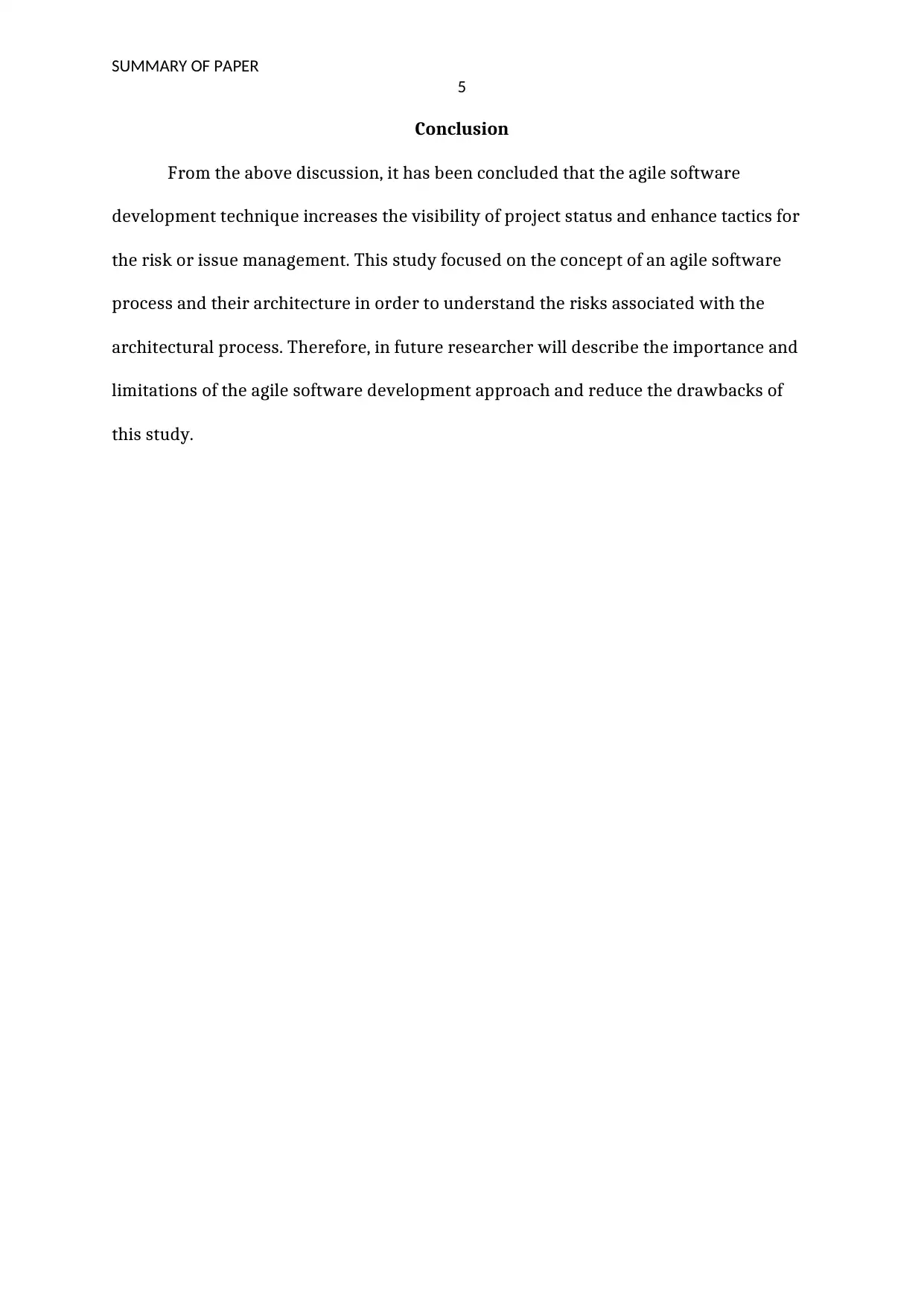
SUMMARY OF PAPER
5
Conclusion
From the above discussion, it has been concluded that the agile software
development technique increases the visibility of project status and enhance tactics for
the risk or issue management. This study focused on the concept of an agile software
process and their architecture in order to understand the risks associated with the
architectural process. Therefore, in future researcher will describe the importance and
limitations of the agile software development approach and reduce the drawbacks of
this study.
5
Conclusion
From the above discussion, it has been concluded that the agile software
development technique increases the visibility of project status and enhance tactics for
the risk or issue management. This study focused on the concept of an agile software
process and their architecture in order to understand the risks associated with the
architectural process. Therefore, in future researcher will describe the importance and
limitations of the agile software development approach and reduce the drawbacks of
this study.
⊘ This is a preview!⊘
Do you want full access?
Subscribe today to unlock all pages.

Trusted by 1+ million students worldwide

SUMMARY OF PAPER
6
References
Ozkaya, I., Gagliardi, M., & Nord, R. L. (2013). Architecting for Large Scale Agile Software
Development: A Risk-Driven Approach. CARNEGIE-MELLON UNIV PITTSBURGH
PA SOFTWARE ENGINEERING INST.
6
References
Ozkaya, I., Gagliardi, M., & Nord, R. L. (2013). Architecting for Large Scale Agile Software
Development: A Risk-Driven Approach. CARNEGIE-MELLON UNIV PITTSBURGH
PA SOFTWARE ENGINEERING INST.
1 out of 7
Your All-in-One AI-Powered Toolkit for Academic Success.
+13062052269
info@desklib.com
Available 24*7 on WhatsApp / Email
![[object Object]](/_next/static/media/star-bottom.7253800d.svg)
Unlock your academic potential
Copyright © 2020–2025 A2Z Services. All Rights Reserved. Developed and managed by ZUCOL.

